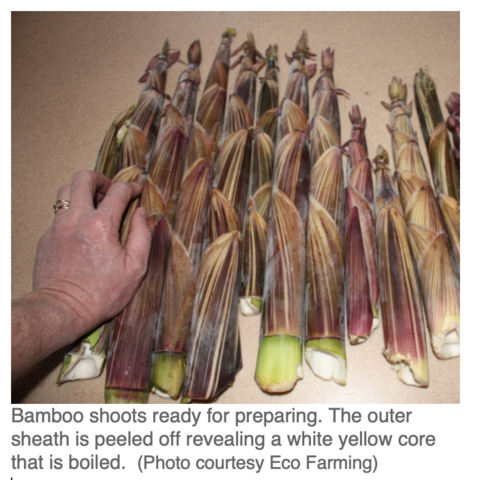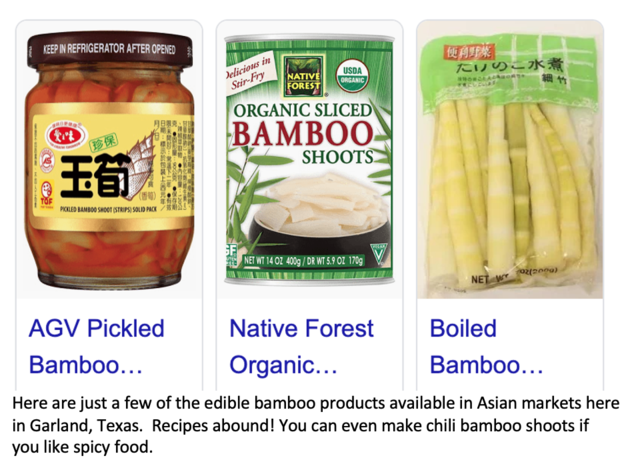Bamboo: It’s A Grass and it’s all over Garland, Texas!
and you can find it at the Garland Community Garden.
Lots of surprises and things to learn in our Community Garden--about plants and other cultures in our community too! Be sure and stop by the Garland Community Garden April 24 from 9AM to 5PM. We are celebrating our 7th Anniversary.
Bamboo belongs to the grass family Poaceae. The long straight stalks of this giant grass can reach up to 100 feet tall depending on the species. Bamboo in more temperate climates is usually less than half that size, but tropical bamboos can reach staggering heights. The stalks are jointed and hollow, often growing in thick stands.
The above-ground portion of bamboo is called the culm (Latin for stalk is culmus). It consists of the main stem, leaves and inflorescence. The sections of the main stalk are broken down into culms and interculms, commonly described as nodes and internodes. These internodes are hollow, and the nodes are solid. These hollow sections of stalk between the nodes are normally airtight and have many uses. NOTE: Because they are airtight, one should not throw bamboo on a campfire as it can explode.
Most of the bamboo in Garland spreads by a rhizome root system and thus can be invasive. Thus, it requires sensible management.There are two types of bamboo root systems; clumping and running. Running bamboo spreads by rhizomes and can be invasive. We have bamboo growing all over Garland--particularly in areas near our creeks. Bamboo has hundreds, perhaps thousands of uses. In the 1880s when the USA was still a plant-based and not petroleum-based economy, Thomas Edison fired up a factory for making filaments for his light bulbs using black bamboo for filaments.
EATING BAMBOO
Yes, bamboo is edible. I got this education from members or our Asian community 6 years ago in the spring of our second year of the garden. People began to arrive and ask me if they could harvest the bamboo shoots.
Unlike tropical climates, the season for eating young shoots in most of the United States is limited to spring, because the closer to the equator one gets, bamboo send up shoots nearly year-round. Even so, for such an important vegetable staple in other parts of the world, I’m amazed it’s not a big commercially produced vegetable here in the United States.
YES, BAMBOO IS NUTRITIOUS
Just one cup of shoots, after boiling, has cellulose, fiber, trace minerals, amino acids, 1.84 kcal of energy, 1.84 g of protein, 2.3 g of carbohydrates, fats (saturated, unsaturated, omega-3 and omega-6 fatty acids), 14 mg of calcium, 0.29 mg iron, 4 mg magnesium, 24 mg phosphorus, 640 mg potassium, 5 mg sodium, 0.56mg zinc, 0.024 mg thiamin, 0.060 mg riboflavin, 2 mg folate and various other vitamins. Like most vegetables, many vitamins and nutrients are cooked out when boiling, therefore finding or growing species that are safe eaten raw is beneficial. (Bamboo is not one of them. It needs to be cooked because of its slight toxicity. My Asian friends tell me that boiling for 20 minutes does the trick.)
Bamboo is an important forage crop around the world for various animals, both wild and domesticated. Almost 100 percent of the giant panda’s diet consists of bamboo. Gorillas, elephants, rats and chimps also eat bamboo. We could feed some of the animals in the zoos around Garland in the spring with all the bamboo we have growing wild in our city.

HARVESTING AND PREPARING BAMBOO SHOOTS
Yes, bamboo can only be harvested in the spring here in Garland, but it can be preserved and enjoyed year-round.
If you want to preserve bamboo shoots, as many people do worldwide, there are various methods such as: fermentation alone or fermentation and then dehydration; pickled; salted; seeds or sap made into beer or wine; and bamboo rice (bamboo seeds) or white rice infused with bamboo extract. Bamboo helps sustain millions of people worldwide with food, shelter and various other uses.
Bamboo is harvested just as the tips of new growth are poking up about six inches from the ground. Using a sharp knife, the harvester cuts off close to the ground. After taking it home, the tough sheath is peeled off, revealing a yellowish white inner layer. This inner layer is then prepared by boiling for eating or preserving for eating later.

WALKING IN A BAMBOO FOREST/GROVE
I don’t recommend it in Garland, just yet. In order for a grove to be safe for the public, it needs to have wide paths cleared for walking and I would recommend some sort of snake repellent for the area. But being inside a bamboo forest is a wonderful feeling. It’s a feeling of being wrapped in the blanket of nature. I’ve been in the ones in Vietnam and I’ve also been in the one at the Garland Community Garden. For our local garden I wore safety glasses and boots (for snakes and stubble). Unprepared groves are not safe for the general public as your eyes could get scratched by the leaves and you might come across a copperhead here in Garland.